#CC-130J
Text
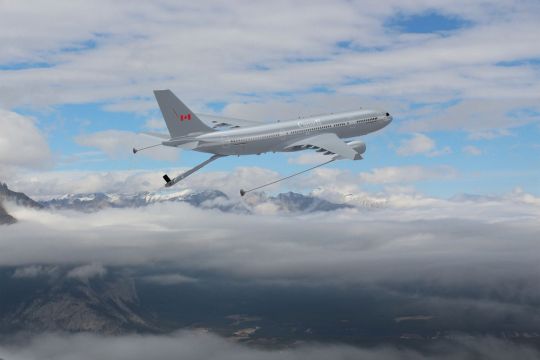
Government of Canada orders 4 new Airbus A330 MRTTs
Diego Alves By Diego Alves 07/26/2023 - 12:00m Military
In an effort to strengthen its continental defense capabilities, the government of Canada granted Airbus Defence and Space a contract for four newly built Airbus A330 Multi Role Tanker Transport (MRTT) aircraft and the conversion of five used A330-200s.
With an order value of approximately CAD $3 billion, this Strategic Air Transport and Refueling Capacity (STTC) initiative aims to replace the former CC-150 Polaris fleet (A310 MRTT) currently operated by the Royal Canadian Air Force (RCAF).
The A330 MRTT was considered the appropriate solution to Canada's requirements to protect its sovereignty and improve operations within the North American Aerospace Defense Command (NORAD) and NATO. “As the most advanced multi-mission tanker in the world, the A330 MRTT perfectly meets the needs of Canada,” said Mike Schoellhorn, executive director of Airbus Defence and Space. The aircraft's superior technological capabilities, combined with its interoperability with other allied client nations of the A330 MRTT, position it ahead of global competition.
The new A330-200 fleet will be set up in Toulouse, France, and will undergo a conversion at the A330 MRTT facility in Getafe, Spain, from 2025. The first MRTT is scheduled for delivery to the RCAF in 2027. The A330 MRTTs will be equipped with refueling options via hoses, drugs and booms, along with cybersecurity solutions and countermeasures. In addition, the aircraft will have the Airbus Medical Evacuation kit solution, with two Intensive Care Units and additional stretchers.

The contract includes advanced training services, featuring the Full Flight Simulator, to ensure crew readiness and modernize the air operational training infrastructure of the Canadian Armed Forces. Airbus was selected as the only qualified supplier for the replacement of the C-150 refuel after an acquisition process opened in April 2021.
With 76 requests from 15 customers and proven combat experience in theaters such as the Middle East and the Eastern Flank in Europe, the A330 MRTT has a market share of 90% outside the US and more than 270,000 flight hours. The history of interoperability, mission success and high availability rates of this mature platform highlights its remarkable performance and makes it the ideal choice for Canada's strategic defense needs.
Tags: A330 MRTTairbusMilitary AviationRCAF - Royal Canadian Air Force/Canada Air Force
Sharing
tweet
Diego Alves
Diego Alves
Related news
MILITARY
Concerns about the numbers of the RAF in the North Atlantic
26/07/2023 - 17:00
MILITARY
Poland buys Swedish early warning aircraft for $58 million
26/07/2023 - 13:00
COMMERCIAL
P&W says that "significant" number of engines of the A320neo family will have to be inspected "immediately"
25/07/2023 - 11:00
MILITARY
Delays in the delivery of the F-35 will cost Lockheed hundreds of millions in 2023
25/07/2023 - 09:00
MILITARY
Argentine Air Force awaits a "superior" proposal to choose F-16
24/07/2023 - 15:00
MILITARY
Indian Air Force considers A-400M, C-130J and C-390 to replace the average transport fleet
4 notes
·
View notes
Text
Northolt Night Photoshoot 16th March 2023
The latest in the long running series of night photoshoots at RAF Northolt took place on the 16th March 2023. Chris Wood was there for GAR.
The largest aircaft the grace the Northolt ramp was this CC-130J Super Hercules © Chris Wood – Global Aviation Resource
The event was organised as usual by Phil Dawe MBE and his team, with the approval and co-operation of RAF Northolt. All the funds raised…

View On WordPress
0 notes
Video
RCAF CC130 by galenburrows
#Aviation#aircraft#airplane#Air Force#RCAF#royal canadian air force#CC130#CC-130J#C130#C-130J#Hercules#Cytr#YTR#flight#flying
19 notes
·
View notes
Video
Operation LENTUS by Robert Sullivan
Via Flickr:
A Royal Canadian Air Force (RCAF) Lockheed CC-130J Hercules from 436 (Transport) Squadron disembarks passengers from Kashechewan First Nation, Ontario in Kapuskasing, Ontario on May 7, 2018 during a precautionary evacuation in support of a request for assistance from the Province of Ontario. The area was threatened by nearby flooding.
9 notes
·
View notes
Photo

CC-130J-30 #c130 #cc130j #cc130c30 #canada #canadianairforce #fairford #riat2019 #aviation #airforce #avgeek #aviationphotography #aircraft #aviationlovers #planespotting #airplane #flight #fly #flying #aviationdaily #aviationgeek #aviationpics #militaryaviation https://t.co/TdS8zNBx2e
2 notes
·
View notes
Photo

With 32 Lockheed C-130 Hercules transports that ranged in age from examples built in 1960 to as recently as 1997, the 32-strong Hercules transport fleet with the Royal Canadian Air Force was approaching the end of their service lives with heavy utilization over the years. In 2006, Canada announced a multi-billion dollar investment in airlift with an order for four Boeing C-17 Globemaster IIIs, 17 Lockheed C-130J-30 Hercules as well as a number of medium lift helicopters. The Hercules order was for the stretched -30 variant which was designated CC-130J in Canadian service. The first two were delivered in June 2010, six months ahead of schedule with the first Canadian Herks deploying to Afghanistan in December of that year. By May 2012, all 17 of the CC-130Js were delivered. With the Hercules order worth $1.4 billion, included were nearly $900 million in industrial offsets benefiting Canadian industry. Compared to the older Hercules models flown by the Canadians, the CC-130Js are more capable and require only three crew (two pilots and a loadmaster) compared to five with the older aircraft. The new Hercules transports are assigned to 8 Wing at CFB Trenton, Ontario. #Avgeek #aviation #aircraft #planeporn #KAFW #AFW #AllianceAirport #FWAAS2017 #AllianceAirShow2017 #airport #planespotting #Lockheed #CC130J #Hercules #RCAF #instagramaviation #aviationlovers #aviationphotography #mil_aviation_originals #instaaviation #aviationlovers #aviationphotography #flight #AvGeeksAero #AvGeekNation #AvgeekSchoolofKnowledge (at Fort Worth Alliance Airport) https://www.instagram.com/p/B3TF0sEBQWx/?igshid=1j5esy74itr9e
#avgeek#aviation#aircraft#planeporn#kafw#afw#allianceairport#fwaas2017#allianceairshow2017#airport#planespotting#lockheed#cc130j#hercules#rcaf#instagramaviation#aviationlovers#aviationphotography#mil_aviation_originals#instaaviation#flight#avgeeksaero#avgeeknation#avgeekschoolofknowledge
3 notes
·
View notes
Text
It’s just after lunch on a cold, dreary Wednesday in Eastern Ontario, Canada. A pristine lake with mist settled above the waters sits quietly, surrounded by densely-forested hills, cabins and cottages scattered around the shores. A dull noise in the distance approaches, turning quickly into a roar as two grey C-130J Super Hercules tactical airlift transports race over a hill at altitudes so low, you could probably touch their bellies if you raised your hands above your head.
In the cockpit of Burma 2-1, the lead Herc in this two-ship formation, we’re dodging missiles fired off by unseen enemy combatants on the ground. Captain Jeff Moorhouse calmly calls out missile launches as the two aircraft in Burma Flight maneuver in response. You can feel the G forces coming on as the Herc suddenly banks, its left wing aimed at the ground and the horizon turning into a rapidly decreasing obtuse angle. My 2 lb Canon camera somehow feels like it’s now 30 lbs, and I’m hefting it to my face, trying to grab a shot of the spectacular scene unfolding right in front of me as I sit in the jump seat behind the two pilots of Burma 2-1.
Of course, we’re not trying to outfox real missiles – this is just a drill, but a highly realistic mission nonetheless. Today, I get to fly with the best of Canada’s best on a training run in a C-130J (known as the CC-130J in Canadian military parlance) at altitudes that would make most ordinary pilots feel thoroughly uncomfortable, especially in an aircraft of this size. It’ll be a two-ship flight, meaning that two Super Hercs will fly this mission, always in close formation throughout the entire flight… even during takeoff. These two aircraft belong to one of the most storied Canadian transportation units in existence – 436 Transport Squadron of the Royal Canadian Air Force’s 8 Wing, based out of Canadian Forces Base Trenton.
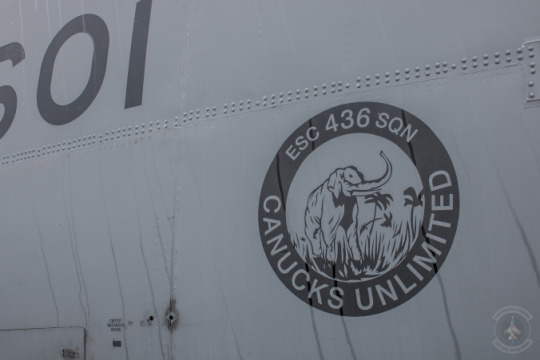
436 Squadron traces its lineage back to the Second World War, where it was officially stood up in 1944 in India to serve as a forward-deployed logistics support element for Allied forces fighting the Imperial Japanese military in neighboring countries. 436 soon became known as “Canucks Unlimited”, and its pilots and crew earned a reputation for themselves thanks to their adoption of a spartan lifestyle and highly rigorous training methods. In order to save time between sorties, crew opted to eat dry meals instead of hot cooked meals, spurning a luxury widely available to aircrew at Allied bases. Maintenance methods were revamped by the squadron’s innovative engineering officer, who devised a way for crews to swap out their aircraft’s engines in two days instead of the usual three, returning grounded aircraft back to flight status quickly. Back then, Douglas C-47s, known as Dakotas in Canada, were 436’s workhorse of choice. In the years since, the highly-dependable C-130 filled that role. Today, we’re flying in the most advanced C-130s in the world, the Super Hercules.
Escorting me on-base today is Lieutenant Karyn Mazurek, a career military officer who formerly served on Canadian naval warships before her current job in public affairs. Lt. Mazurek and I are ushered into a briefing room upon reaching 436’s hangars. This room lined with computers hooked up to databases networks full of information which aircrew study intensely prior to a flight. We’re told to turn off our phones as we enter, and we quietly stand at a table. Everything is timed perfectly, and to that end, the officer leading the briefing calls out warnings prior to the start of the information session. Data sheets relevant to the training mission are handed out and everybody gets a copy. What we’re witnessing is actually called a “concept”, where everything the pilots and aircrew need to know about the mission they’ll soon fly is disseminated via ranking officers and critical personnel, like air traffic controllers and weather monitors. Today’s flight is a training exercise – two new pilots will be getting more hands-on time with the C-130J under the watchful eyes of experienced tactically-qualified pilots, while a pair of loadmasters will also be training, one as a new instructor, also observed by another experienced trainer.
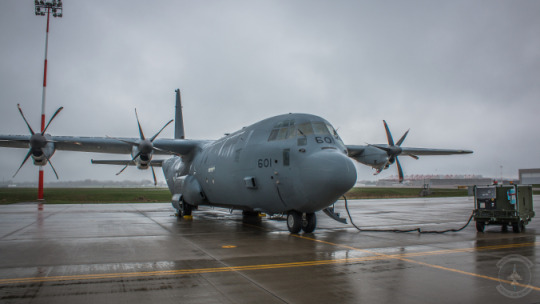
Fin 601, aka “Senior”. Copyright: Ian D’Costa, 2017
Every flight is assigned a callsign, and the two aircraft flying today are labeled “Burma Flight”, a pointed reminder of the squadron’s history in the Asian theater of the Second World War. The lead aircraft will be dropping a pair of pallets, one on the ground in a COFF (Combat OFFload), and the other while in the air in a traditional airdrop. In combat situations, Hercules aircrew are expected to be fully proficient on these methods of battlefield supply delivery. The pallets we’ll be flying with are loaded down with weights to simulate an actual load; in battle, they’ll be chock full of ammunition, rations, gear, and other vital necessities for soldiers on the ground. Though C-130s are designed to land virtually anywhere, there are situations which require airdrops – cargo offloaded while in-flight through the rear main door of the aircraft – because landing the aircraft is simply out of the question for safety purposes. The RCAF has been doing this for years, ever since they bought their first C-130 legacy Hercs. Today, I’ll get to see them doing it with the newest technology available to them.
We’re bussed out the flight line, a neat row of dark gray C-130Js sitting quietly before us. I’m going to go up with Burma 2-1, the lead aircraft in the flight. For this run, 2-1 is assigned Fin 601, the very first C-130J delivered to the RCAF… so technically, I’m sitting on a piece of history. But before Fin 601 can be loaded up, it needs to be pre-flighted. As we’re technically flying with three loadmasters today, the three of them go about the preflight together with one observing and the other two executing. It’s rigorous and every minute detail is checked and rechecked. Nothing can be left to chance. It’s not just for the sake of those flying in the Herc, but it’s also for the sake of everyone they support on the ground. If an aircraft is disabled or incapacitated in any way, that puts the soldiers these aircraft are designed to support at a distinct disadvantage, and for the airmen of 436 Squadron, many of whom have and maintain ties to the Canadian Army’s infantry community, failure simply won’t do.
This slideshow requires JavaScript.
After the loadmasters strap the cargo in using a forklift to help with the lift, a quick lunch and another pre-flight brief later, we’re now in the final prep stages for mission launch. Captains Joe Tufenkdjian and Jeff Moorhouse are Burma 2-1’s aircraft commander (left seat) and first officer (right seat) respectively. Now fully strapped into the jumpseat, it doesn’t take very long for a loud whine to fill the cockpit. We’ve switched to the aircraft’s auxiliary power unit and the ground power unit has been disconnected. A few short minutes later, the aircraft rumbles and vibrates noticeably – the first engine has been fired up and brought to idle. The pilots do the same for each engine in the startup sequence while communicating with air traffic control to get the necessary clearances and
“Burma 2-1, you’re cleared to Runway 06, hold till Burma 2-2 converges.”
Through the right-side windshield, we see Burma 2-2 holding short on a taxiway, ready for the formation takeoff. 2-2 will close in behind us on the runway, entering its takeoff roll when we’re all the way through ours. After lifting off, 2-1 and 2-2 will meet up and maintain that formation all the way through the flight. We begin banking away from Trenton on our climb, farmland falling away below us. But we don’t climb very high as today’s mission is meant to be flown at a low level. Most aircraft as big as the C-130 aren’t built to do this, but the Hercules excels at it. We’ll be flying through valleys, skirting hills and ridges, and we’re doing it through “bad guy country”. That means that everybody on the ground is hostile unless we’re informed otherwise, and they’re trying to kill us.
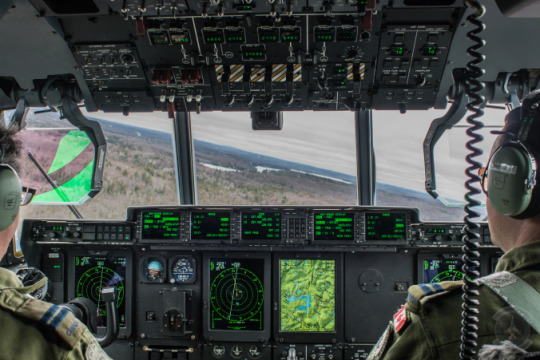
Copyright: Ian D’Costa, 2017
For any farmers and spring vacationers out there who might’ve heard or seen Burma Flight fly over, don’t worry, you’re not actually hostile combatants. 2-1 and 2-2’s pilots need practice avoiding the most common threat they’d face overseas in a country like Afghanistan – man-portable air defense systems, or MANPADS for short. And in no time, we’re under attack. And like the professionals they are, 2-1 and 2-2’s pilots quickly and efficiently respond to these attacks with a variety of tricks up their sleeves, keeping their aircraft and the important cargo in their holds safe and sound, still on track for the drop. Even FedEx couldn’t get delivery done as well as Burma Flight’s about to do it. We fly on through Eastern Ontario, banking sharply low over lakes and rivers, rising over hills when the terrain avoidance system voices its concern with repeated “Terrain, terrain, pull up!” warnings. It’s thoroughly shocking and yet highly comforting at the same time that Capts. Tufenkdjian and Moorhouse are idly chatting about the weather, sports, snowmobiles and vacation home property values while we’re roaring low over Ontario, passing small towns and logging camps in the blink of an eye. Somewhere behind us, at our 5 or 6 o’clock position, is Burma 2-2 doing the same thing. These two pilots are so damned good at their jobs that they make today seem like just another walk in the park for them.
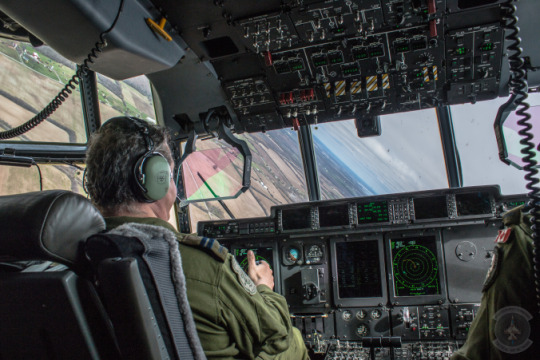
Capt. Joe Tufenkdjian at the helm of Burma 2-1 while en route to the training area for today’s flight. Copyright: Ian D’Costa, 2017
Over the ICS, I hear Capt. Moorhouse talk with one of the loadmasters on the flight. “Reporter wants to get some time on the ramp with his camera, let’s do it. Someone come get him.” He turns around and asks me if I’m okay with the change in plan – originally, we were considering me going out on the ramp after concluding the airdrop, but this plan works better. I flash him a thumbs up and respond affirmatively via the ICS. Hell yes, I’m ready! Having never done this before, I grab the helmet and make for the ladder before anybody changes their mind, not that they will. Master Corporal Jared “Jay” Conroy is there to greet me and get me harnessed-up.
I’m still getting my bearings, stumbling through the hold while we’re hitting turbulence every so often. One of the loadmasters helps me into a harness and I put a borrowed flight helmet on, replete with a tinted visor and microphone. Jay and I move to the back of the aircraft and we hook into the floor. Jay disappears from my line of sight to manipulate a set of controls. The ramp soon drops and I start to stumble towards the gaping maw in front of me, forests, rivers and lakes falling behind us quickly. But I don’t have time to be uneasy because I get to feast my eyes on an incredible sight… out of nowhere, Burma 2-2, the second C-130J in the flight swoops into sight, parrying with the winds assaulting it. I’ve never seen or experienced anything like this in my life and my first instinct is to grab my camera. Buffeting winds make taking pictures of the trailing aircraft nearly impossible but I grab a few shots. Jay motions to me to sit down, and I do. At times, we bank so steeply that I need to hold onto the rollers on the floor of the ramp to keep me from shifting down.
It’s awesome.
This slideshow requires JavaScript.
We’re zipping along merrily, the second C-130 flying less than 1000 feet behind. The brilliance of the situation I’m in gets to me and I start laughing as though I’ve completely lost my sanity. There I am, sitting on an open-air ramp at the back of an aircraft traveling hundreds of miles an hour in turbulent skies, hooked up to a solitary nylon strap behind me… and I’m having the time of my life! Jay has served in the Canadian Forces for over sixteen years, having begun his career in the military as an enlisted armored infantry soldier in the Canadian Army Reserve; an open ramp of a C-130 is the last place you’d expect to find an armored crewman. However, I look over and I see him casually enjoying the view, a grin stretching from ear to ear. This is just another day at work for him, but the experience never gets old.
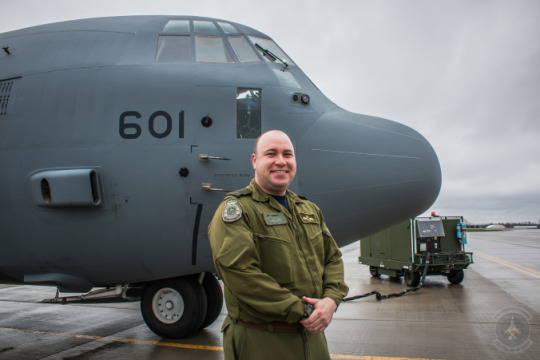
MCpl Jared “Jay” Conroy stands in front of Fin 601, one of two CC-130J-30 Super Hercules transporters on today’s mission. Copyright: Ian D’Costa, 2017
The job of a Hercules loadmaster is very involved and challenging. The aircraft essentially becomes the loadmaster’s baby for the duration of the mission. His or her responsibility ranges from helping power the aircraft up from its dormant stage by plugging it into a GPU (a ground power unit), checking the hydraulically-actuated cargo ramp, to calculating weight and balance and appropriately distributing the cargo load to help keep the aircraft at a stable attitude while in-flight. Conroy is known as a combat-qualified loadmaster, meaning that he’s capable of doing his job under the stresses of battle. In fact, he’s already deployed with the C-130J to Afghanistan, having flown strategic airlift missions out there in support of coalition forces on the ground. For him and other airmen, one of the biggest perks of the job isn’t just getting to see the world – which they do a lot of – but it’s getting to fly in ways no ordinary person could ever fathom. “We were over Portugal once, and we dropped the ramp… I was just sitting there admiring the view below me, it was incredible! You don’t see that on a civilian jet … just amazing!” recalls Jay of an RCAF mission that took him to Western Europe and beyond.
We eventually make it back into the hold of the aircraft and Jay closes up the ramp. The C-130J is very similar to every other Herc I’ve ever been in, yet incredibly different. The one I’m on today was one of 17 C-130J-30s purchased by the Canadian Forces in 2008 with deliveries beginning a few years later. The -30 is the longest iteration of the C-130 line, which got its start in the mid-1950s. It possesses a glass cockpit with an array of multifunction displays, two heads up displays (HUDs) which projects important data on a see-through screen in front of the pilots faces, allowing them to keep their eyes outside their aircraft instead of constantly pointed at the cockpit’s instruments, and it only needs a crew of three to function – two pilots and a loadmaster, instead of the older Hercules’s crew of five (a flight engineer and navigator were the other two roles required). It can essentially do everything its predecessors, known as “legacy” Hercs, can do, and more.

Loadmaster Jay Conroy preps a pallet for the CDS drop. Copyright: Ian D’Costa, 2017
I’m back in the cockpit and Capt. Moorhouse chimes in over the comms again: “How was it?” I yell back “Awesome! Can’t wait to do it again!” before I realize I didn’t key my microphone. Moorhouse laughs and resumes paying attention to flying. The C-130J is his first fleet flying assignment in the RCAF, and he’s been at it ever since the Super Hercules entered Canadian service. “It’s a great plane, love it, nothing like it and it’s perfect for the job” says Moorhouse when we land. Having served with the Canadian Forces since 2006, he encourages prospective pilots to consider flying with the RCAF and notes that flight experience has never really been a prerequisite, having never flown an aircraft himself before he joined up. “You get to see and do incredible things … things you would never get to do in a civilian airliner, we get to do in military aircraft. The experience is well worth it.” he says.
We’re still very low over the countryside, but it’s almost time for the highlight of today’s mission – the airdrop, also known as a Cargo Delivery System (CDS) drop. Behind us, in the hold, the loadmasters have rigged up the cargo and they’re ready to do the drop. I clamber back down and am seated towards the front of the hold while Jay and another loadmaster move to the back of the aircraft. The ramp opens and the outside world comes back into focus. We don’t have to wait long, the aircraft’s attitude changes and its nose lifts, angling the hold slightly. Once again, timing is everything and the aircraft commander coordinates with the loadmasters to ensure the drop occurs within seconds of reaching the drop zone, or DZ for short. A load snapping noise briefly permeates my helmet and the pallet rolls towards the mouth of the ramp. A line connecting a parachute rigged to its top surface and a “static line” hooked up inside the Herc plays out and then goes taut. The parachute billows out, arresting the descent of the heavy pallet full of supplies and who-knows-what destined for the DZ we’re now climbing away from. Burma 2-2 does the same and re-enters formation.
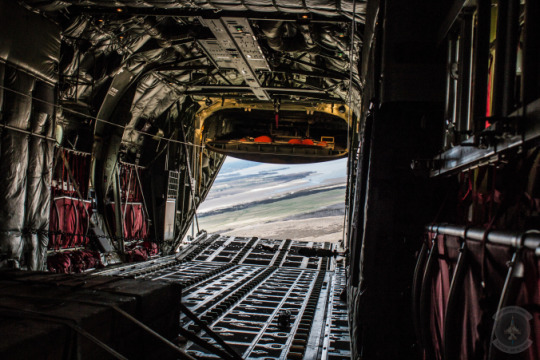
Soon after dropping the first pallet, as we bank away from the drop zone. Copyright: Ian D’Costa, 2017
It’s almost time for the second feature of today’s show, the COFF. A combat offload is basically what Herc crews do when there’s no forklift around to help unload the aircraft. Similar to the widebody civilian airliners I’ve worked on in the past, the C-130’s cargo hold has rollers on its floor to facilitate the movement of large pallets bearing all sorts of cargo. Crew push the pallets into place, then lock them down using sturdy chains and straps to keep them from shifting; load-shift while in-flight can bring down an aircraft, and that’s the last thing anybody wants. During a COFF, a crew will use Newton’s first law of motion: “An object at rest stays at rest and an object in motion stays in motion with the same speed and in the same direction unless acted upon by an unbalanced force.” This basically means that any object sitting at rest will tend to stay that way unless a force is inflicted upon it. In the same way, a COFF involves using the inertia of the heavy pallet in the hold, a rapid forward movement and a sudden brake in order to drop the pallet out the rear, using the rollers to smoothen out the motion. This is exactly what we do upon landing and moving out to a taxiway. The pallet falls away from the C-130, and the ramp closes. In minutes, we’re back up in the air.
The remainder of the flight involves touch-and-go landing practice, which Burma 2-1 executes with ease and precision. We’ll later find out on the bus ride out of the flight line that 2-1 hit their DZ during the airborne drop with absolutely perfect aim – full points. Today, the crews of Burma 2-1 and 2-2 have flown at altitudes so low you can see your shadow chase after you on the ground, clear as day. They’ve outmaneuvered and warded off attacks by ghost teams of enemy combatants, dropped thousands of pounds out the back of the aircraft onto a drop zone with pinpoint accuracy, many feet below us, and hurled another thousand pounds out the back of the Hercules upon landing as though that’s a totally normal thing for any aircraft to be able to do. Today, Burma Flight has done things no ordinary aircraft or aircrew is capable of without even breaking a sweat. This is all in a day’s work for the highly professional aviators of Canada’s only Super Hercules tactical airlift squadron.
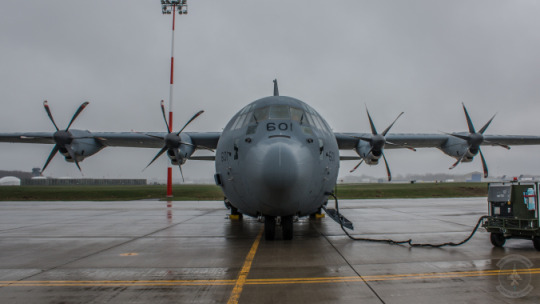
Copyright: Ian D’Costa, 2017
A huge thanks to Lt. Karyn Mazurek of 8 Wing, the members of 436 Squadron, and the crews of Burma 2-1 and 2-2 for their graciousness in hosting me, entertaining my incessant questions with patience, and tolerating my constant photography! Allowing me to observe what you do in serve of your country was both an honor and a privilege!
Editor-in-Chief Ian D'Costa gets to go behind the scenes with the RCAF's 436 Squadron in a C-130J Super Hercules! Check out the full experience in the link. It's just after lunch on a cold, dreary Wednesday in Eastern Ontario, Canada. A pristine lake with mist settled above the waters sits quietly, surrounded by densely-forested hills, cabins and cottages scattered around the shores.
#436 Squadron#436 Transport Squadron#8 Wing#Air force#airborne drop#airdrop#behind the scenes#C-130#C-130J#C-130J-30#Canucks Unlimited#cargo delivery system#CC-130J#CDS#CFB Trenton#COFF#combat offload#container delivery system#Lockheed C-130 Hercules#Lockheed Martin#Military#Ontario#RCAF#Royal Canadian Air Force#Super Hercules
0 notes
Text

RCAF Lockheed Martin CC-130J-30 Hercules (L-382) Hawaiian Shirt
0 notes
Text

Rcaf Lockheed Martin Cc-130J-30 Hercules (L-382) Hawaiian Shirt
0 notes
Text

Tnlt2007Bc11 Rcaf Lockheed Martin Cc-130J-30 Hercules (L-382) Hawaiian Shirt
0 notes
Text

Rcaf Lockheed Martin Cc-130J-30 Hercules (L-382) Hawaiian Shirt
0 notes
Text

Canada reveals planned deadline for purchase of four new A330 MRTT tankers
Fernando Valduga By Fernando Valduga 08/14/2022 - 11:06 AM in Military
The complete plan of the Royal Canadian Air Force (RCAF) for the creation of a modern fleet of tankers was revealed this week with the announcement that the first of the four new Airbus A330 MRTT aircraft will be delivered in 2028.
The government has determined that Airbus is the only qualified supplier for the new tankers and expects the agreement, worth up to US$ 5 billion, to be signed next April. The new aircraft will add significant capabilities to the RCAF not only in terms of supplying its future fleet of F-35 fighters, but also for transporting troops and cargo.
The spokeswoman for the Department of National Defense, Jessica Lamirande, said that the government has not yet received the proposal.

New A330 MRTT will replace the CC-150 Polaris aircraft.
The Canadian Air Force originally planned to buy six new aircraft, but bought two used A330-200 passenger planes ?? which will paint with RCAF paint and minimally adapt the planes to put them into service. Among its functions will be VIP transportation. After the arrival of the new aircraft, RCAF plans to send the used ones to Airbus for full conversion to MRTT version.
The government paid about $50 million for each of the aircraft manufactured in 2015 from International Airfinance Corp., a global aircraft leasing company.
These used aircraft will be, after an intermediate period of operations since the other four new aircraft must be purchased.
The new aircraft are part of Canada's Strategic Tanker Transport Capability project, intended to replace the existing CC-150 Polaris aircraft, piloted by the Royal Canadian Air Force. These refueling and transport aircraft have been in operation since 1992.
Tags: A330 MRTTairbusMilitary AviationRCAF - Royal Canadian Air Force/Canada Air Force
Previous news
MAYHEM PROJECT: USAF's secret plan to develop a hypersonic bomber
Next news
Lockheed receives $7.6 billion to build 129 F-35 fighters from Lot 15
Fernando Valduga
Fernando Valduga
Aviation photographer and pilot since 1992, he has participated in several events and air operations, such as Cruzex, AirVenture, Dayton Airshow and FIDAE. He has works published in a specialized aviation magazine in Brazil and abroad. He uses Canon equipment during his photographic work in the world of aviation.
Related news
MILITARY
How L3Harris created the new U.S. special operators' plane to hunt and attack terrorists
08/14/2022 - 8:10 PM
New Airbus A350-900 delivered to Aeroflot is already being used to supply parts to other aircraft.
COMMERCIAL
Russian airline begins to cannibalize aircraft to keep its jets in the air
08/14/2022 - 6:32 PM
MILITARY
Lockheed Martin presents the first C-130J-30 Super Hercules of the Indonesian Air Force
08/14/2022 - 2:49 PM
MILITARY
Lockheed receives $7.6 billion to build 129 F-35 fighters from Lot 15
08/14/2022 - 11:25 AM
MILITARY
MAYHEM PROJECT: USAF's secret plan to develop a hypersonic bomber
08/14/2022 - 00:02
COMMERCIAL
Emirates boss wants Airbus to design a new type of A380
08/13/2022 - 7:21 PM
HOME Main Page Editorials Information Events Collaborate SPECIALS Advertise About
Cavok Brasil - Digital Tchê Web Creation
Commercial
Executive
Helicopters
History
Military
Brazilian Air Force
Space
SPECIALS
Cavok Brasil - Digital Tchê Web Creation
3 notes
·
View notes
Text
Northolt Night Photoshot - October 2022
Northolt Night Photoshot – October 2022
This autumn’s night photoshoot season has been a busy one. After a three year hiatus as a result of the Covid 19 pandemic, it saw the welcome return of the Northolt night photoshoot. Chris Wood was there and reports for GAR.
Canadian CC-130J from 436 Squadron at Canadian Forces Base Trenton © Chris Wood – Global Aviation Resource
The Northolt night photoshoots have became a staple of the aviation…

View On WordPress
0 notes
Video
RCAF CC130J by galenburrows
#Aviation#aircraft#airplane#flight#flying#RCAF#royal canadian air force#CC130#CC-130J#C-130J#C-130#Hercules#t
17 notes
·
View notes
Video
Exercise TRIDENT JUNCTURE by Robert Sullivan
Via Flickr:
A Lockheed CC-130J prepares to take off for a parachute drop at Tancos Airfield, Portugal, during JOINTEX 15 as part of NATO’s Exercise Trident Juncture 15 on October 28, 2015.
5 notes
·
View notes
Photo

CC-130J-30 #c130 #cc130j #cc130c30 #canada #canadianairforce #fairford #riat2019 #aviation #airforce #aircraft #militaryaviation https://t.co/hLzEI9A5rN
1 note
·
View note

